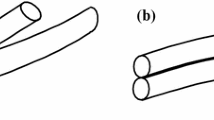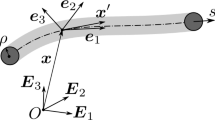Abstract
In this paper we propose a finite element approach which simulates the mechanical behaviour of beam assemblies that are subject to large deformations and that develop contact-friction interactions. We focus on detecting and modeling contact-friction interactions within the assembly of beams. Contact between beams—or between parts of the same beam in the case of self-contact, is detected from intermediate geometries defined within proximity zones associating close parts of beam axes. The discretization of contact-friction interactions is performed on these intermediate geometries by means of contact elements, constituted of pairs of material particles which are predicted to enter into contact. A 3D finite strain beam model is used to represent the behaviour of each beam. This model describes the kinematics of each beam cross-section using nine degrees of freedom, and is therefore able to represent plane deformations of these cross-sections. Algorithms are proposed to solve the global nonlinear problem using an implicit scheme, under quasi-static assumptions. Simulation results of the tightening and releasing of knots made on monofilament and multifilament yarns are shown as an application. Straight fibers are first twisted together to make a yarn, before suitable conditions are applied to their ends to form and tighten the knot. Tightening forces are finally released to obtain an equilibrium configuration of the knot without external forces.
Similar content being viewed by others
References
Bajas H, Durville D, Ciazynski D, Devred A (2010) Numerical simulation of the mechanical behavior of iter cable-in-conduit conductors. IEEE Trans Appl Supercond 20(3): 1467–1470
Bergou M, Wardetzky M, Robinson S, Audoly B, Grinspun F (2008) Discrete elastic rods. ACM Trans Graph (TOG) 27(3)
Bertails F, Audoly B, Cani MP, Querleux B, Leroy F, Lévêque JL (2006) Super-helices for predicting the dynamics of natural hair. ACM Trans Graph 25: 1180–1187
Bertails-Descoubes F, Cadoux F, Daviet G, Acary V (2011) A nonsmooth newton solver for capturing exact coulomb friction in fiber assemblies. ACM Trans Graph 30: 6:1–6:14
Chamekh M, Mani-Aouadi S, Moaker M (2009) Modeling and numerical treatment of elastic rods with frictionless self-contact. Comput Methods Appl Mech Eng 198(47–48): 3751–3764
Chamoret D, Saillard P, Rassineux A, Bergheau JM (2004) New smoothing procedures in contact mechanics. J Comput Appl Math 168(1–2): 107–116
Clauvelin N, Audoly B, Neukirch S (2009) Matched asymptotic expansions for twisted elastic knots: a self-contact problem with non-trivial contact topology. J Mech Phys Solids 57(9): 1623–1656
Coleman B, Swigon D (2000) Theory of supercoiled elastic rings with self-contact and its application to dna plasmids. J Elast 60: 173–221
Durville D (2005) Numerical simulation of entangled materials mechanical properties. J Mater Sci 40: 5941–5948
Durville D (2010) Simulation of the mechanical behaviour of woven fabrics at the scale of fibers. Int J Mater Form 3: 1241–1251
Durville D (2011) Contact modelling in entangled fibrous materials. In: Zavarise G, Wriggers P. (eds) Trends in computational contact mechanics. Lecture notes in applied and computational mechanics. Springer, Berlin, pp 1–22
Goyal S, Perkins NC, Lee CL (2008) Non-linear dynamic intertwining of rods with self-contact. Int J Non-Linear Mech 43(1): 65–73
Konyukhov A, Schweizerhof K (2010) Geometrically exact covariant approach for contact between curves. Comput Methods Appl Mech Eng 199(37–40): 2510–2531
Konyukhov A, Schweizerhof K (2011) On a geometrically exact theory for contact interactions. In: Zavarise G, Wriggers P (eds) Trends in computational contact mechanics. Lecture notes in applied and computational mechanics. Springer, Berlin, pp 41–56
Litewka P (2011) Multiple-point beam-to-beam contact finite element. In: CMM-2011 computer methods in mechanics. Warsaw, Poland
Litewka P, Wriggers P (2002) Contact between 3d beams with rectangular cross-sections. Int J Numer Methods Eng 53(9): 2019–2041
Litewka P, Wriggers P (2002) Frictional contact between 3d beams. Comput Mech 28: 26–39
Pieranski P, Kasas S, Dietler G, Dubochet J, Stasiak A (2001) Localization of breakage points in knotted strings. New J Phys 3(1): 10
Przybyl S, Pieranski P (2009) Tightening of the elastic overhand knot. Phys Rev E 79: 031801
Spillmann J, Teschner M (2008) An adaptive contact model for the robust simulation of knots. Comput Graph Forum 27(2): 497–506
Torre A, Bajas H, Ciazynski D, Durville D, Weiss K (2011) Mechanical-electrical modeling of stretching experiment on 45 Nb 3 Sn strands ciccs. IEEE Trans Appl Supercond 21(3): 2042–2045
van der Heijden GHM, Neukirch S, Goss VGA, Thompson JMT (2003) Instability and self-contact phenomena in the writhing of clamped rods. Int J Mech Sci 45(1): 161–196
Wrigger P, Zavarise G (1997) On contact between three-dimensional beams undergoing large deflections. Commun Numer Methods Eng 13(6): 429–438
Zavarise G, Wriggers P (2000) Contact with friction between beams in 3-d space. Int J Numer Methods Eng 49(8): 977–1006
Author information
Authors and Affiliations
Corresponding author
Rights and permissions
About this article
Cite this article
Durville, D. Contact-friction modeling within elastic beam assemblies: an application to knot tightening. Comput Mech 49, 687–707 (2012). https://doi.org/10.1007/s00466-012-0683-0
Received:
Accepted:
Published:
Issue Date:
DOI: https://doi.org/10.1007/s00466-012-0683-0




